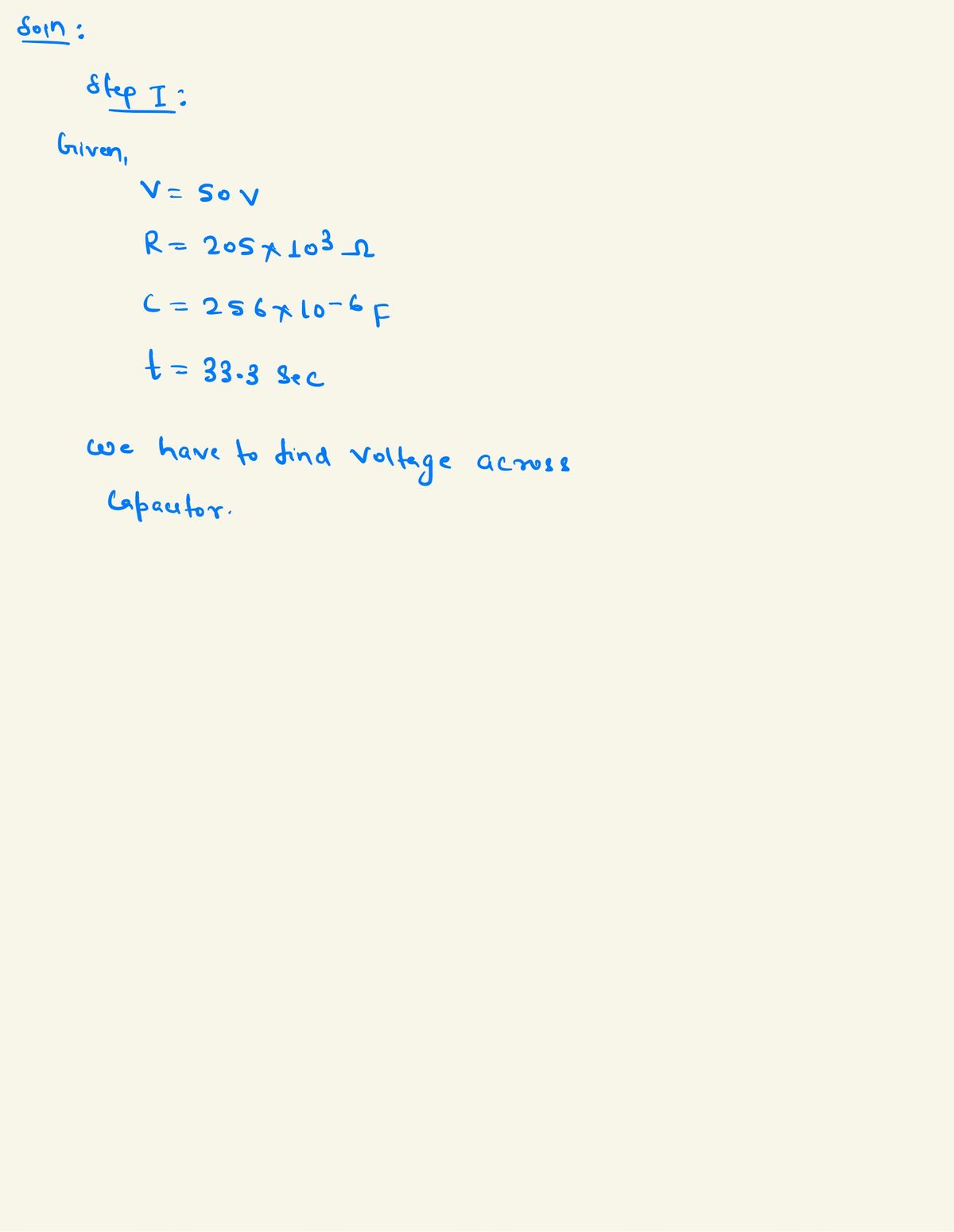50.0 V Consider the circuit with R = 205 kQ and C = 256 µF. If the capacitor is initially uncharged, what will be the magnitude of the voltage in volts across the capacitor at a time 33.3 seconds after the switch is closed? (Enter answer as a positive number with 1 digit right of decimal. Do not enter unit.)
50.0 V Consider the circuit with R = 205 kQ and C = 256 µF. If the capacitor is initially uncharged, what will be the magnitude of the voltage in volts across the capacitor at a time 33.3 seconds after the switch is closed? (Enter answer as a positive number with 1 digit right of decimal. Do not enter unit.)
College Physics
11th Edition
ISBN:9781305952300
Author:Raymond A. Serway, Chris Vuille
Publisher:Raymond A. Serway, Chris Vuille
Chapter1: Units, Trigonometry. And Vectors
Section: Chapter Questions
Problem 1CQ: Estimate the order of magnitude of the length, in meters, of each of the following; (a) a mouse, (b)...
Related questions
Question
![**RC Circuit Analysis: Voltage Across a Capacitor**
Consider the circuit diagram provided, which includes a resistor (\( R \)) with a resistance of 205 kΩ and a capacitor (\( C \)) with a capacitance of 256 μF. The circuit is powered by a 50.0 V source.
**Problem Statement:**
If the capacitor is initially uncharged, determine the magnitude of the voltage across the capacitor at a time 33.3 seconds after the switch is closed. Provide your answer as a positive number with one digit to the right of the decimal point. Do not include units.
**Circuit Diagram Explanation:**
- The circuit consists of a series connection of a resistor and a capacitor.
- The voltage source, labeled as 50.0 V, is connected in series with these components.
- The circuit will behave as an RC charging circuit, where the voltage across the capacitor increases over time as it charges through the resistor.
**Calculating Voltage Across the Capacitor:**
To solve this problem, one would typically use the following formula for the voltage (\( V_c \)) across the capacitor in an RC charging circuit:
\[
V_c(t) = V \cdot \left(1 - e^{-\frac{t}{RC}}\right)
\]
Where:
- \( V \) is the voltage of the battery (50.0 V).
- \( t \) is the time after the switch is closed (33.3 seconds).
- \( R \) is the resistance (205,000 Ω).
- \( C \) is the capacitance (256 × 10^-6 F).
- \( e \) is the base of the natural logarithm (approximately 2.71828).
Substitute the values into the formula to compute the result.](/v2/_next/image?url=https%3A%2F%2Fcontent.bartleby.com%2Fqna-images%2Fquestion%2F7bd4008c-0e04-4739-a817-034fe415e209%2F45e067d9-2c97-41cf-ae78-4a3ceadbba8f%2F12der9t_processed.jpeg&w=3840&q=75)
Transcribed Image Text:**RC Circuit Analysis: Voltage Across a Capacitor**
Consider the circuit diagram provided, which includes a resistor (\( R \)) with a resistance of 205 kΩ and a capacitor (\( C \)) with a capacitance of 256 μF. The circuit is powered by a 50.0 V source.
**Problem Statement:**
If the capacitor is initially uncharged, determine the magnitude of the voltage across the capacitor at a time 33.3 seconds after the switch is closed. Provide your answer as a positive number with one digit to the right of the decimal point. Do not include units.
**Circuit Diagram Explanation:**
- The circuit consists of a series connection of a resistor and a capacitor.
- The voltage source, labeled as 50.0 V, is connected in series with these components.
- The circuit will behave as an RC charging circuit, where the voltage across the capacitor increases over time as it charges through the resistor.
**Calculating Voltage Across the Capacitor:**
To solve this problem, one would typically use the following formula for the voltage (\( V_c \)) across the capacitor in an RC charging circuit:
\[
V_c(t) = V \cdot \left(1 - e^{-\frac{t}{RC}}\right)
\]
Where:
- \( V \) is the voltage of the battery (50.0 V).
- \( t \) is the time after the switch is closed (33.3 seconds).
- \( R \) is the resistance (205,000 Ω).
- \( C \) is the capacitance (256 × 10^-6 F).
- \( e \) is the base of the natural logarithm (approximately 2.71828).
Substitute the values into the formula to compute the result.
Expert Solution
Step 1

Step by step
Solved in 2 steps with 2 images

Recommended textbooks for you

College Physics
Physics
ISBN:
9781305952300
Author:
Raymond A. Serway, Chris Vuille
Publisher:
Cengage Learning

University Physics (14th Edition)
Physics
ISBN:
9780133969290
Author:
Hugh D. Young, Roger A. Freedman
Publisher:
PEARSON

Introduction To Quantum Mechanics
Physics
ISBN:
9781107189638
Author:
Griffiths, David J., Schroeter, Darrell F.
Publisher:
Cambridge University Press

College Physics
Physics
ISBN:
9781305952300
Author:
Raymond A. Serway, Chris Vuille
Publisher:
Cengage Learning

University Physics (14th Edition)
Physics
ISBN:
9780133969290
Author:
Hugh D. Young, Roger A. Freedman
Publisher:
PEARSON

Introduction To Quantum Mechanics
Physics
ISBN:
9781107189638
Author:
Griffiths, David J., Schroeter, Darrell F.
Publisher:
Cambridge University Press

Physics for Scientists and Engineers
Physics
ISBN:
9781337553278
Author:
Raymond A. Serway, John W. Jewett
Publisher:
Cengage Learning

Lecture- Tutorials for Introductory Astronomy
Physics
ISBN:
9780321820464
Author:
Edward E. Prather, Tim P. Slater, Jeff P. Adams, Gina Brissenden
Publisher:
Addison-Wesley

College Physics: A Strategic Approach (4th Editio…
Physics
ISBN:
9780134609034
Author:
Randall D. Knight (Professor Emeritus), Brian Jones, Stuart Field
Publisher:
PEARSON